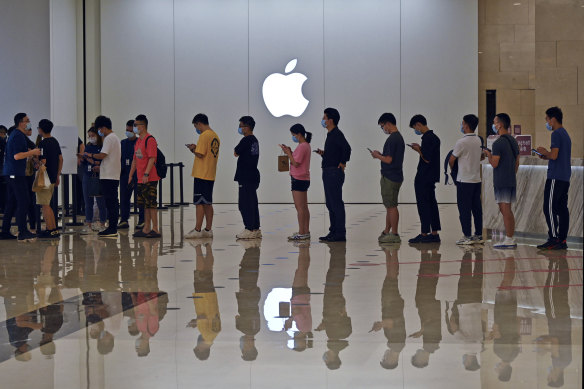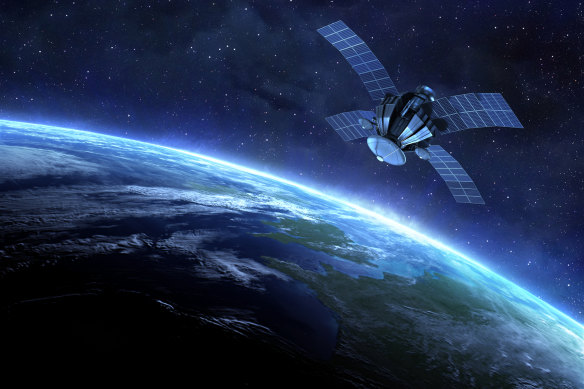Deep in the wilderness, disaster strikes. You fall suddenly, feeling a sharp pain stabbing through your leg, and find you cannot stand up. Pulling out your mobile phone in the hope of calling for help, colour drains from your face as you look at the screen – zero bars of signal.
If you are lucky, weighing down your backpack is a back-up satellite phone to call for help. These hefty devices, reminiscent of the first mobiles sold in the 1980s, connect to orbiting satellites and are used by extreme adventurers, on ships, or in war zones and disaster areas devoid of mobile communications.
Apple is set to release its newest iPhone this week.Credit:AP
These expensive and unwieldy devices use powerful technology to connect to satellites hurtling around the earth at hundreds of miles an hour. It is a difficult trick to pull off.
Smartphone manufacturers have traditionally avoided this technology. That could be about the change. Soon, you could be catching up on your WhatsApps via satellite from the iPhone in your pocket.
On Wednesday, Apple is expected to reveal its iPhone 14. The new device will come with multiple cameras, 5G connectivity and a superfast processor. But one differentiating factor could be teased by the technology company – mobile satellite connectivity.
Analysts claim that notoriously secretive Apple is a customer of satellite company Globalstar, which recently disclosed a $US300 million ($441 million) contract with an unnamed customer.
Rumours that Apple’s satellite announcement is imminent have been fuelled by its teaser poster for its iPhone launch event, which features a night’s sky and the phrase “Far Out”.
According to Tim Farrar, an analyst at TMF Associates, Apple “could offer a service straight away and could extend it to an iMessage offering in future”. Globalstar’s satellite network is already well established.
Apple is not the only company working on satellite technology.
Earlier this month, T-Mobile said it was teaming up with Elon Musk, the world’s richest man, and his $US100 billion company SpaceX to provide coverage to rural areas across the US. Other companies, such as Vodafone-backed AST SpaceMobile, a $US2 billion satellite company, and Lynk are also planning to beam down mobile networks from space.
Getting regular phones to work on satellite networks has historically proved too difficult.
Connecting mobile phones to satellites offers the promise of eliminating so-called coverage “not-spots”, letting people make calls and send texts wherever they are in the world.
T-Mobile chief executive Mike Sievert and Musk promised to bring about “the end of mobile dead zones” using SpaceX’s Starlink satellite network.
However, the product is some way off. T-Mobile doesn’t expect to start early testing until late next year. “We’re not here to announce the product yet,” Sievert admitted. Musk added the technology was still “a hard problem, that’s why it has not been solved before”. Satellite phones are not new. Motorola-backed satellite phone network Iridium has long made bulky satellite phones.
The business model has also been patchy. In 2000, the US government bailed out Iridium, which had collapsed with $US4 billion in debt.
Eric Dowek, marketing director at chip design company AccelerComm, says: “People have tried this before. The bankruptcy of Iridium proves it is more challenging than most people anticipate. The satellites are a lot further away, and the quality of the channel is worse than what you would have in a terrestrial network.”
Getting regular phones to work on satellite networks has historically proved too difficult. Mobile phones using 3G or 4G spectrum were not tuned to the signals broadcast by communications satellites orbiting hundreds of thousands of miles above Earth.
Now, however, these connections are close to reality. Modern 5G phones are capable of connecting to higher spectrum frequencies, which were once reserved for satellite communications. Starlink’s service will utilise “mid-band” terrestrial spectrum loaned from T-Mobile that even 4G mobile phones can link to.
But even still, this service will only be able to offer connections of two to four megabits per second. “The initial service will be for sending and receiving texts,” a T-Mobile spokesman says, although Musk has promised calls and video will follow soon after.
“It is inconceivable that Apple will have a fully functioning satellite phone. What they might do is turn the phone or watch into a ‘beacon’.”
On Thursday, Google also confirmed it was “designing for satellites” in its next version of its Android smartphone software.
If Apple does announce satellite communications on Wednesday, its service will be extremely limited too.
Ben Wood, an analyst at CCS Insight, says: “It is inconceivable that Apple will have a fully functioning satellite phone. What they might do is turn the phone or watch into a ‘beacon’.”
The iPhone or Apple Watch could be set up to send out a distress signal, which would only be a tiny data package, in an emergency to a satellite.
Apple’s project is still shrouded in mystery, but it reportedly faces its own hurdles. While its hardware has been tested for satellite connections, delays are still possible until “Apple and operators can settle the business model”, according to a report from Apple supply chain analysts at TF Securities.
If anyone can make it work, it is the iPhone giant. Two decades after Iridium’s first attempts, Apple has its sights firmly set on conquering one of the smartphone’s final frontiers.
Telegraph, London
Get news and reviews on technology, gadgets and gaming in our Technology newsletter every Friday. Sign up here.
Most Viewed in Technology
From our partners
Source: Read Full Article

